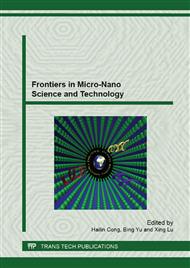[1]
L. Feng, S. Li, Y. Li, H. Li, L. Zhang, J. Zhai, Y. Song, B. Liu, L. Jiang, D. Zhu, Super-hydrophobic Surface from Natural to Artificial, Adv. Mater. 14 (2002) 1857.
DOI: 10.1002/adma.200290020
Google Scholar
[2]
M. Ma, R.M. Hill, Superhydrophobic surfaces, Curr. Opin. Colloid. In. 11 (2006) 193-202.
Google Scholar
[3]
H Y Erbil, A L Demirel, Y Avci and O Mert, Transformation of a simple plastic into a superhydrophobic surface, Science. 299(2003)1377-1380.
DOI: 10.1126/science.1078365
Google Scholar
[4]
Y T Cheng , D E Rodak, Is the lotus leaf superhydrophobic? Appl. phys let. 86(2005)144101-144103.
DOI: 10.1063/1.1895487
Google Scholar
[5]
Y C Hong, H S Uhm, Superhydrophobicity of a material made from multiwalled carbon nanotubes, Applied physics letter. 88(2006)244101-244103.
DOI: 10.1063/1.2210449
Google Scholar
[6]
K J Tang, X F Wang, W F Yan, J H Yu, R R Xu, Fabrication of superhydrophilic Cu2O and CuO membranes, Journal of Membrane Science. 286 (2006)279-284.
DOI: 10.1016/j.memsci.2006.10.005
Google Scholar
[7]
X L Liu, Z H Jiang, J Li, Z H Zhang, L Q Ren, Super-hydrophobic property of nano-sized cupric oxide films, Surface & Coatings Technology. 204(2010)3200-3204.
DOI: 10.1016/j.surfcoat.2010.03.012
Google Scholar
[8]
Z. Guo, W. Liu, Biomimic from the superhydrophobic plant leaves in nature: binary structure and unitary structure, Plant. Sci. 172 (2007) 1103.
DOI: 10.1016/j.plantsci.2007.03.005
Google Scholar
[9]
X F Gao, Jiang L, Water-repellent legs of water striders, Nature 432(2004)36.
DOI: 10.1038/432036a
Google Scholar
[10]
T L Sun, L Feng, X F Gao, L Jiang, Bioinspired Surfaces with Special Wettability, Accounts of Chemical Research. 38(2005)644-652.
DOI: 10.1021/ar040224c
Google Scholar
[11]
Z G Guo, W M Liu, Progress in Biomimicing of Super-Hydrophobic Surface, Progress in Chemistry. 18(2006)721-726.
Google Scholar
[12]
W Barthlott and C Neinhuis, Purity of the sacred lotus, or escape from contamination in biological surfaces, Planta. 202(1997)1-8.
DOI: 10.1007/s004250050096
Google Scholar
[13]
H. Zhang, Z. Jiang, X. Liu, J. Lian, An investigation of smooth nanosized copper films on glass surface by improved electroless plating, Surf. Rev. Lett. 13 (2006) 471-476.
DOI: 10.1142/s0218625x0600844x
Google Scholar
[14]
T Young, An essay on the cohesion of fluids, Philos. Trans. R. Soc. London 95(1805) 65-87.
Google Scholar


